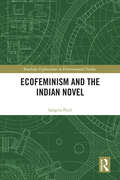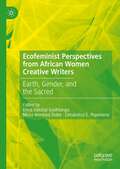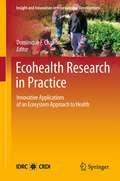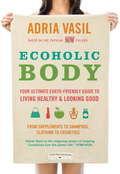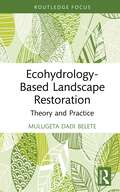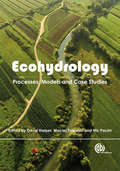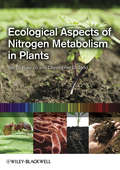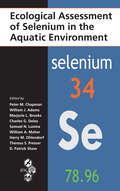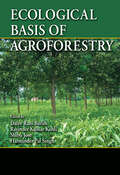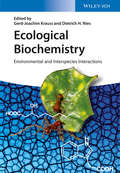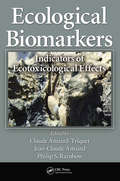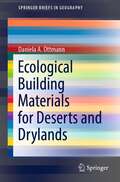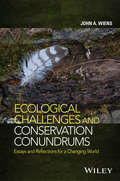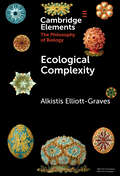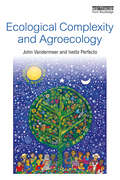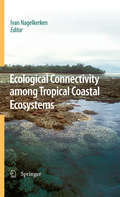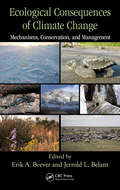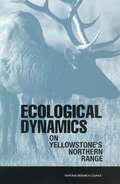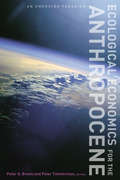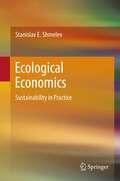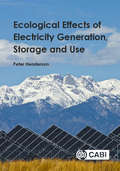- Table View
- List View
Ecofeminism and the Indian Novel (Routledge Explorations in Environmental Studies)
by Sangita PatilEcofeminism and the Indian Novel tests the theories of ecofeminism against the background of India’s often different perceptions of environmental problems, challenging the hegemony of Western culture in thinking about human problems. This book moves beyond a simple application of the concepts of ecofeminism, instead explaining the uniqueness of Indian novels as narratives of ecofeminism and how they can contribute to the development of the theory of ecofeminism. In examining a selection of novels, the author argues that Indian texts conceptualize the ecological crisis more as a human problem than as a gender problem. The book proposes that we should think of ecofeminism as ecohumanism instead, seeing human beings and nature as a part of a complex web. Novels analysed within the text include Kamala Markandaya’s Nectar in a Sieve (1954), Shivram Karanth’s Return to Earth (2002) and Na D’Souza’s Dweepa (2013). Ecofeminism and the Indian Novel will be of great interest to students and scholars of ecofeminism, ecocriticism, ecological feminism, environmental humanities, gender studies, ecological humanities, feminist studies and Indian literature.
Ecofeminist Perspectives from African Women Creative Writers: Earth, Gender, and the Sacred
by Enna Sukutai Gudhlanga Musa Wenkosi Dube Limakatso E. PepeneneThis volume explores contemporary African women’s creative writing, highlighting their contributions to ecofeminist theology. Contributors address the following questions: How do contemporary African women writers depict the Earth/land/environment and its relationship to women in various contexts? How is religion featured in African women’s writing? How does religious literature (scriptures) form an intertextual layer in African women’s writing? The contributors proceed by analyzing the intersection of religion, gender, class, sexuality, colonialism, and ecology in selected texts written by African women. They bring these texts into conversation with broader eco-feminist theological scholarship, exploring the potential of literary writing to contribute to theological discourse of liberation and social justice in the African and global arena.
Ecohealth Research in Practice
by Dominique F. CharronThis book is about doing innovative research to achieve sustainable and equitable change in people's health and well-being through improved interactions with the environment. It presents experiences from the field of ecosystem approaches to health (or ecohealth research) and some insights and lessons learned. It builds on previous literature, notably Forget (1997), Forget and Lebel (2001), Lebel (2003), and Waltner-Toews et al. (2008). Through case-studies and other contributions by researchers supported by Canada's International Development Research Centre (IDRC), the book presents evidence of real changes in conditions of people, their health, and the ecosystems that support them. These changes were derived from applications of an ecosystem approach to health in developing regions of the world. The book also illustrates the resulting body of applied, participatory, and action research that improved health and environmental management in developing countries and, in many cases, influenced policies and practices.
Ecoholic Body: Your Ultimate Earth-friendly Guide to Living Healthy and Looking Good
by Adria VasilAdria Vasil, Canada's straight-shooting green living expert, is back, and this time it's personal . . . care, that is. Her latest eco bible delivers the lowdown on virtually every product that comes into contact with our bodies. From the pollutants clogging your sinus meds all the way to the outlaw toxins leaching from your sandals, ECOHOLIC BODY has you covered, head to toe. Never shy to blow the whistle, Adria calls out supplement and shampoo makers that exaggerate their green cred. This witty, indispensable guide will arm you with the knowledge you need to keep you and your family healthy, happy and green, all while detoxing the planet. Look your best- "Mean 15" ingredients to avoid- Skin care reviews for moisturizers, sunscreen, anti-aging and acne- Fresh ways to fight funk from bad breath to B.O.- Toxin-free hair care that works- The lowdown on mineral makeup, natural cosmetics, tattoos and more Feel your best- Nature's best remedies and superfoods that are good for the planet and your body- Greening your health care- Pollution-triggered health problems- Ecoholic weight loss plan- Greener birth control, local sex toys and more Dress your best- All the latest eco fashions, including activewear, maternity clothes, lingerie, menswear, footwear, jewellery, wedding dresses and more Give your kids nature's best- Toxin-free bum balms, shampoos, bubble bath, oils and powders- Green diaper reviews- The scoop on kids' PJs, clothes, charms And more- Exhaustive testing guides for everything from natural deodorant to herbal shampoos- Made-in-Canada products and services- Coast-to-coast store directory- DIY recipes for homemade body care- Money-saving tips in every chapterose hands touched? She rehearsed the questions she wondered if she would ever be able to ask. Why do you do it? Is it necessary to your poetry? Why did you choose this job? Or did it choose you?-- from The Murder RoomFrom the Hardcover edition.
Ecohydrology-Based Landscape Restoration: Theory and Practice (Routledge Focus on Environment and Sustainability)
by Mulugeta Dadi BeleteThis book provides an introduction to a fairly new approach to natural resources management practice entitled ecohydrology-based landscape restoration. Ecohydrology-based landscape restoration integrates landscape restoration practices with ecohydrology science and principles in order to help address the limitations of current management practices in developing countries. Focusing on both the theory and practice of implementing new management practices, the book includes conceptual designs and practical demonstrations for a variety of sites, including hillsides, farmlands, gullies, riparian buffers and wetlands, while also drawing on field research conducted in Ethiopia. The book puts forward principles for improving current practices, which include the better integration of hydrological and ecological concerns, the greater involvement of local communities, the adoption of indigenous practices, the establishment of green and semi-grey infrastructure as an ecohydrological systemic solution and the necessity of taking an adaptive approach to managing landscapes. This book will be of great interest to students and scholars of water resource management, ecohydrology and landscape restoration as well as professionals involved in the restoration of landscapes in developing countries.
Ecohydrology: An Approach to the Sustainable Management of Water Resources
by Maciej Zalewski Nic Pacini David HarperEcohydrology is an emerging new sub-discipline which links elements of ecology with hydrology at all points in the water cycle, ranging in scale from water-plant physiological relationships to whole catchment water-ecosystem processes. This book pays most attention to the larger scales of ecohydrology, emphasizing the use of this tool in striving towards the goal of sustainable water management. Authors from Eastern and Western Europe, America, Australia and South Africa give a broad global context.
Ecological Aspects of Nitrogen Metabolism in Plants
by Joe C. Polacco Christopher D. ToddEcological Aspects of Nitrogen Acquisition covers how plants compete for nitrogen in complex ecological communities and the associations plants recruit with other organisms, ranging from soil microbes to arthropods. The book is divided into four sections, each addressing an important set of relationships of plants with the environment and how this impacts the plant’s ability to compete successfully for nitrogen, often the most growth-limiting nutrient. Ecological Aspects of Nitrogen Acquisition provides thorough coverage of this important topic, and is a vitally important resource for plant scientists, agronomists, and ecologists.
Ecological Assessment of Selenium in the Aquatic Environment
by William J. Adams Peter M. Chapman Marjorie L. Brooks Charles G. Delos Samuel N. Luoma William A. Maher Harry M. Ohlendorf Theresa S. Presser D. Patrick ShawBased on the work and contributions of 46 scientists, managers, and policymakers, Ecological Assessment of Selenium in the Aquatic Environment documents the state of the science and explores how to use this information when assessing and managing the environmental effects of Se. A focused discussion on the fate and effects of Se in aquatic ecosyste
Ecological Basis of Agroforestry
by Shibu Jose Ravinder Kumar Kohli Harminder Pal Singh Daizy Rani BatishFaced with the growing problems of climate change, ecosystem degradation, declining agricultural productivity, and uncertain food security, modern agricultural scientists look for potential relief in an ancient practice. Agroforestry, if properly designed, can mitigate greenhouse effects, maintain ecosystem health and biodiversity, provide food sec
Ecological Biochemistry
by Dietrich H. Nies Gerd-Joachim KraussThe first stand-alone textbook for at least ten years on this increasingly hot topic in times of global climate change and sustainability in ecosystems.Ecological biochemistry refers to the interaction of organisms with their abiotic environment and other organisms by chemical means. Biotic and abiotic factors determine the biochemical flexibility of organisms, which otherwise easily adapt to environmental changes by altering their metabolism. Sessile plants, in particular, have evolved intricate biochemical response mechanisms to fit into a changing environment. This book covers the chemistry behind these interactions, bottom up from the atomic to the system's level.An introductory part explains the physico-chemical basis and biochemical roots of living cells, leading to secondary metabolites as crucial bridges between organisms and the respective ecosystem. The focus then shifts to the biochemical interactions of plants, fungi and bacteria within terrestrial and aquatic ecosystems with the aim of linking biochemical insights to ecological research, also in human-influenced habitats.A section is devoted to methodology, which allows network-based analyses of molecular processes underlying systems phenomena.A companion website offering an extended version of the introductory chapter on Basic Biochemical Roots is available at http://www.wiley.com/go/Krauss/Nies/EcologicalBiochemistry
Ecological Biomarkers: Indicators of Ecotoxicological Effects
by Philip S. Rainbow Jean-Claude Amiard Claude Amiard-TriquetDoes a change, which affects a few biological macro-molecules, some cells, or a few individuals within a population, have any ecological significance that would allow the prediction of deleterious effects at higher levels of biological organization, namely the population, community, and ultimately the ecosystem? With contributions from experts in t
Ecological Building Materials for Deserts and Drylands (SpringerBriefs in Geography)
by Daniela A. OttmannThis book examines prospective climate adaptive building materials in desert and drylands in the context of climate change, desertification, urbanisation demands, and the consequent sustainable urban development challenges. This preliminary collection of ecological materials covers the characterisation of biotic and abiotic resources for materials, their specifications and benefits for adequate bio-climatic design and construction. Particular emphasis is given to ecological composite materials for advances in desert architecture. Based on the initial collection, the book culminates with potentials for new ecological building materials. The "eComposite Combinator" matrix offers potential research recipes and encourages the reader to conduct further climate-matters related research.
Ecological Census Techniques
by William J. SutherlandVirtually any exercise in ecology will require some knowledge of the techniques for carrying out a census of population numbers. This practical text outlines clearly, with worked examples, the main techniques used by field ecologists to enumerate plants and animals. Each taxonomic group is treated separately, with detailed descriptions of appropriate census methods; their advantages, disadvantages and biases. Techniques for measuring a wide range of environmental variables are also included. The final chapter lists the 20 most common censusing sins. Concise yet comprehensive, this book provides a unique overview of the most important methods for those working on field studies in population and behavioural ecology and conservation biology at all levels, from the beginner to the practising professional.
Ecological Challenges and Conservation Conundrums
by John A. Wiensy, reading the essays together fosters a broader perspective on the issues. Readers will be able find out how the ecological systems they strive to conserve are affected by various forces of change, and how this affects the way they should approach the issues. Collectively, the essays encompass many of the central issues that are shaping ecology and conservation as the world changes. The essays are arranged by topic and each includes a short introduction that updates the context and explains why the essay was written. Six brand new essays have been written specifically for this volume to fill the in the area. In all, this book may help to prompt a shift in how scientists, managers, and the public think about these key issues. Brief TOC: Concluding comments: are bird communities real?; On skepticism and criticism in ornithology; Word processing versus writing; The place of long-term studies in ornithology; Ecology 2000: An essay on future directions in ecology; Fat times, lean times and competition among predators; Scientific responsibility and responsible ecology; Landscape ecology: the science and the action; Found! The survivor in the swamps; What's so new about ecosystem services?; Will land-use change erode our conservation gains?; The dangers of black-and-white conservation; The demise of wildness?; Uncertainty and the relevance of ecology; Polar bears, golden toads, and conservation futures; The eclipse of history?; "It was the best of times, it was the worst of times..."; Is 'monitoring' a dirty word?; Moving outside the box; Tipping points in the balance of nature; Stewart Udall and the future of conservation; Oil, oil, everywhere; Being green isn't easy; From our southern correspondent(s); Shooting at a moving target; Black swans and outliers; Taking risks with the environment; Wildlife, people, and water: Who wins?
Ecological Climatology
by Gordon B. BonanThis book introduces an interdisciplinary framework to understand the interaction between terrestrial ecosystems and climate change. It reviews basic meteorological, hydrological and ecological concepts to examine the physical, chemical and biological processes by which terrestrial ecosystems affect and are affected by climate. The textbook is written for advanced undergraduate and graduate students studying ecology, environmental science, atmospheric science and geography. The central argument is that terrestrial ecosystems become important determinants of climate through their cycling of energy, water, chemical elements and trace gases. This coupling between climate and vegetation is explored at spatial scales from plant cells to global vegetation geography and at timescales of near instantaneous to millennia. The text also considers how human alterations to land become important for climate change. This restructured edition, with updated science and references, chapter summaries and review questions, and over 400 illustrations, including many in color, serves as an essential student guide.
Ecological Climatology
by Gordon BonanThe third edition of Gordon Bonan's comprehensive textbook introduces an interdisciplinary framework to understand the interaction between terrestrial ecosystems and climate change. Ideal for advanced undergraduate and graduate students studying ecology, environmental science, atmospheric science, and geography, it reviews basic meteorological, hydrological, and ecological concepts to examine the physical, chemical, and biological processes by which terrestrial ecosystems affect and are affected by climate. This new edition has been thoroughly updated with new science and references. The scope has been expanded beyond its initial focus on energy, water, and carbon to include reactive gases and aerosols in the atmosphere. The new edition emphasizes the Earth as a system, recognizing interconnections among the planet's physical, chemical, biological, and socioeconomic components, and emphasizing global environmental sustainability. Each chapter contains chapter summaries and review questions, and with over 400 illustrations, including many in color, this textbook will once again be an essential student guide.
Ecological Complexity (Elements in the Philosophy of Biology)
by Alkistis Elliott-GravesComplexity has received substantial attention from scientists and philosophers alike. There are numerous, often conflicting, accounts of how complexity should be defined and how it should be measured. Much less attention has been paid to the epistemic implications of complexity, especially in Ecology. How does the complex nature of ecological systems affect ecologists' ability to study them? This Element argues that ecological systems are complex in a rather special way: they are causally heterogeneous. Not only are they made up of many interacting parts, but their behaviour is variable across space or time. Causal heterogeneity is responsible for many of the epistemic difficulties that ecologists face, especially when making generalisations and predictions. Luckily, ecologists have the tools to overcome these difficulties, though these tools have historically been considered suspect by philosophers of science. The author presents an updated philosophical account with an optimistic outlook of the methods and status of ecological research.
Ecological Complexity and Agroecology
by Ivette Perfecto John VandermeerThis text reflects the immense current growth in interest in agroecology and changing approaches to it. While it is acknowledged that the science of ecology should be the basis of agroecological planning, many analysts have out-of-date ideas about contemporary ecology. Ecology has come a long way since the old days of "the balance of nature" and other romantic notions of how ecological systems function. In this context, the new science of complexity has become extremely important in the modern science of ecology. The problem is that it tends to be too mathematical and technical and thus off-putting for the average student of agroecology, especially those new to the subject. Therefore this book seeks to present ideas about ecological complexity with a minimum of formal mathematics. The book’s organization consists of an introductory chapter, and a second chapter providing some of the background to basic ecological topics as they are relevant to agroecosystrems (e.g., soil biology and pest control). The core of the book consists of seven chapters on key intersecting themes of ecological complexity, including issues such as spatial patterns, network theory and tipping points, illustrated by examples from agroecology and agricultural systems from around the world.
Ecological Connectivity among Tropical Coastal Ecosystems
by Ivan NagelkerkenMangrove forests, seagrass beds, and coral reefs are circumtropical ecosystems that are highly productive, and provide many important biological functions and economic services. These ecosystems cover large surface areas in the shallow tropical coastal seascape but have suffered from serious human degradation, especially in the last few decades. Part of their diversity, productivity, and functioning seems to be based on their juxtaposition. Especially in the last decade significant advances have been made on new insights into their ecological connectivity. This authoritative book provides a first-time comprehensive review of the major ecological interactions across tropical marine ecosystems that result from the mutual exchange of nutrients, organic matter, fish, and crustaceans. A group of leading authors from around the world reviews the patterns and underlying mechanisms of important biogeochemical and biological linkages among tropical coastal ecosystems in 15 chapters. Included are chapters that review cutting-edge tools to study and quantify these linkages, the importance of such linkages for fisheries, and how tropical ecosystems should be conserved and managed for sustainable use by future generations. The book uses examples from all over the world and provides an up-to-date review of the latest published literature. This book is a 'must read' for professionals working on the conservation, management, and ecology of mangrove, seagrass and coral reef ecosystems.
Ecological Consequences of Climate Change: Mechanisms, Conservation, and Management
by Jerome Klosowski Jerrold L. BelantContemporary climate change is a crucial management challenge for wildlife scientists, conservation biologists, and ecologists of the 21st century. Climate fingerprints are being detected and documented in the responses of hundreds of wildlife species and numerous ecosystems around the world. To mitigate and accommodate the influences of climate ch
Ecological Dynamics On Yellowstone's Northern Range
by Committee on Ungulate Management in Yellowstone National ParkEcological Dynamics on Yellowstone’s Northern Range discusses the complex management challenges in Yellowstone National Park. Controversy over the National Park Service’s approach of "natural regulation" has heightened in recent years because of changes in vegetation and other ecosystem components in Yellowstone's northern range. Natural regulation minimizes human impacts, including management intervention by the National Park Service, on the park ecosystem. Many have attributed these changes to increased size of elk and other ungulate herds.This report examines the evidence that increased ungulate populations are responsible for the changes in vegetation and that the changes represent a major and serious change in the Yellowstone ecosystem. According to the authors, any human intervention to protect species such as the aspen and those that depend on them should be prudently localized rather than ecosystem-wide. An ecosystem--wide approach, such as reducing ungulate populations, could be more disruptive. The report concludes that although dramatic ecological change does not appear to be imminent, approaches to dealing with potential human--caused changes in the ecosystem, including those related to climate change, should be considered now. The need for research and public education is also compelling.
Ecological Economics for the Anthropocene
by Peter G. Brown Peter TimmermanEcological Economics for the Anthropocene provides an urgently needed alternative to the long-dominant neoclassical economic paradigm of the free market, which has focused myopically-even fatally-on the boundless production and consumption of goods and services without heed to environmental consequences. The emerging paradigm for ecological economics championed in this new book recenters the field of economics on the fact of the Earth's limitations, requiring a total reconfiguration of the goals of the economy, how we understand the fundamentals of human prosperity, and, ultimately, how we assess humanity's place in the community of beings. Each essay in this volume contributes to an emerging, revolutionary agenda based on the tenets of ecological economics and advances new conceptions of justice, liberty, and the meaning of an ethical life in the era of the Anthropocene. Essays highlight the need to create alternative signals to balance one-dimensional market-price measurements in judging the relationships between the economy and the Earth's life-support systems. In a lively exchange, the authors question whether such ideas as "ecosystem health" and the environmental data that support them are robust enough to inform policy. Essays explain what a taking-it-slow or no-growth approach to economics looks like and explore how to generate the cultural and political will to implement this agenda. This collection represents one of the most sophisticated and realistic strategies for neutralizing the threat of our current economic order, envisioning an Earth-embedded society committed to the commonwealth of life and the security and true prosperity of human society.
Ecological Economics for the Anthropocene: An Emerging Paradigm
by Peter G. Brown Peter Timmerman Eds.Ecological Economics for the Anthropocene provides an urgently needed alternative to the long-dominant neoclassical economic paradigm of the free market, which has focused myopically—even fatally—on the boundless production and consumption of goods and services without heed to environmental consequences. The emerging paradigm for ecological economics championed in this new book recenters the field of economics on the fact of the Earth's limitations, requiring a total reconfiguration of the goals of the economy, how we understand the fundamentals of human prosperity, and, ultimately, how we assess humanity's place in the community of beings.Each essay in this volume contributes to an emerging, revolutionary agenda based on the tenets of ecological economics and advances new conceptions of justice, liberty, and the meaning of an ethical life in the era of the Anthropocene. Essays highlight the need to create alternative signals to balance one-dimensional market-price measurements in judging the relationships between the economy and the Earth's life-support systems. In a lively exchange, the authors question whether such ideas as "ecosystem health" and the environmental data that support them are robust enough to inform policy. Essays explain what a taking-it-slow or no-growth approach to economics looks like and explore how to generate the cultural and political will to implement this agenda. This collection represents one of the most sophisticated and realistic strategies for neutralizing the threat of our current economic order, envisioning an Earth-embedded society committed to the commonwealth of life and the security and true prosperity of human society.
Ecological Economics: Sustainability in Practice
by Stanislav E. ShmelevIn a concise and crisp manner, this book presents the state of the art in ecological economics, an interdisciplinary field focused on the analysis of sustainability of global, national and regional economic systems. An elegant guide, the book offers a range of cutting edge methods used in sustainability research including multicriteria decision aid (MCDA), input-output analysis, and life cycle analysis. This book is packed with references for students with some background in economics, environmental science or mathematics who aim to develop the analytical skills required for redirecting our development path towards sustainability in government, international organisations, academia, non-profit sector and business. As such, the book is primarily aimed at MSc and first year PhD students reading for degrees in Environmental Change and Management, Ecological Economics, Environmental Management, Philosophy, Politics and Economics, and those taking part in similar programmes. The book strives to develop the idea that a significant adjustment of the current economic theories is required, an idea supported by the emerged world economic crisis, the climatic and biodiversity crisis the world is currently facing and the enormously slow progress that has been made in the field of reorientation of the global economy towards sustainability. The practical case studies provided focus on the most pressing topics of today, and the book adopts a positive approach for problem solving and strategic development, which is aimed at educating the future decision makers and business leaders.
Ecological Effects of Electricity Generation, Storage and Use
by Dr Peter HendersonThis book reviews the past, present and future generation and use of electricity. While noting the importance of electricity to the well-being of people, it argues that all means of electricity generation have adverse ecological consequences. The ecological effects of all the main forms of electricity generation, storage and transmission are reviewed in 14 chapters. The chapters briefly cover the engineering and physics of each method of electricity generation followed by a description of the different ways in which the technology interacts with the natural world. Finally, sections consider the importance of these impacts and how they can be mitigated or avoided. A final chapter summarizes the issues and emphasizes that the only way to truly minimize the impacts of electricity generation is to reduce our consumption and transmission. Future efforts should continue to focus on increasing the efficiency of light production, refrigeration, electrical appliances and batteries.
